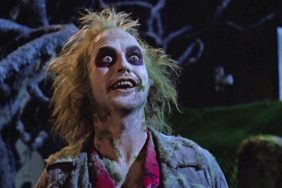5. Ginger Snaps (dir. John Fawcett, 2000)

Motion International
There remains, to this day, a very small number of great werewolf movies in the world. But the best may very well be this Canadian parable, about two teenaged sisters whose lives are torn apart when one of them (Katharine Isabelle) is bitten by a lycanthrope. Soon she has hair growing where there was no hair before, and an uncontrollable desire to act out on her violent and sexual impulses, and her sister (Emily Perkins) has to decide whether to stand by Ginger’s side or follow her own path.
Puberty played out via literal transmogrification may not be a subtle metaphor, but as told by filmmaker John Fawcett it still manages to be a brilliant one. Ginger Snaps twists the werewolf legend ever so slightly, but its strengths lie in the honest performances, sympathetic situations, and the underlying tragedy of growing up, growing apart, and growing fangs. ~ William Bibbiani
4. Saw (dir. James Wan, 2004)

LionsGate
You don’t have to love the sequels to recognize the original Saw for the landmark that it was and the crackerjack thriller it is. James Wan’s maiden voyage into extreme horror isn’t just the sadistic meat grinder it’s reputed to be, it’s a rather sly bit of pulp fiction, loaded with wit and alive with Italian-informed style (Wan himself admitted to key moments in Dario Argento’s Deep Red being an influence). Modest of budget, but high in concept, Saw is perversion of the noir with an almost Ian Fleming-esqe megalomaniacal villain and goosed by a reptilian electronic score by Nine Inch Nails’ Charlie Clouser. ~ Chris Alexander
3. Shaun of the Dead (dir. Edgar Wright, 2004)

Rogue Pictures
George A. Romero reinvented our collective concept of the apocalypse with his Night of the Living Dead movies, envisioning a time in our near future when the dead rise from the grave and overtake the living. It was a concept that audiences were readily willing to accept, but despite repeated attempts to use the zombie uprising as a metaphor for consumerism, the Cold really means. It means that people who fantasize about what they’d do in the undead apocalypse have a lot of growing up to do.
Enter Shaun (Simon Pegg), whose zombie-like arrested development gets a jump-start when actual zombies show up. Like many undead movies, our hero uses the end of the world as an opportunity to reassess his priorities, but his life is so universally and simplistically shoddy that everyone watching Shaun of the Dead feels just like him, and wishes they had an excuse to get their own shit together.
Meanwhile, Wright and Pegg (who co-wrote the screenplay) weave in references to every zombie movie imaginable, kick our ass with one great fight after another, and tug at our heartstrings with deaths that really mean something. Shaun of the Dead may just be the ultimate horror satire: redefining, reassessing, and recapturing what made the whole idea work in the first place. And making us laugh a whole lot, obviously. ~ William Bibbiani
2. American Psycho (dir. Mary Harron, 2000)

LionsGate
Based on the Bret Easton Ellis novel, American Psycho is equal parts horror and satire. Christian Bale is brilliant as Patrick Bateman, the narcissistic, stereotypical 1980s Wall Street guy who is more concerned with fashion and fucking than anything else… with the exception of gruesome, violent murders. The satire is most biting when it pokes fun at Bateman and his “friends’” inability to tell one another apart. The end result is that Bateman literally can’t be held accountable for his swath of murder, no matter how many times he confesses.
As with any good 1980s satire, everything is done to excess – especially the gore. ~ Alyse Wax
Next: #1 (and 50 Runners-Up)








